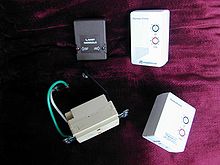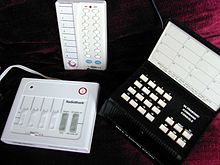X10
X10 is a communications protocol for remote control of electrical devices that uses the existing power line (220V or 110V AC) to transmit control signals between home automation (home automation) equipment in digital format. The X10 devices that are marketed are only for individual use and in domestic environments of up to 250 m², given their limited bandwidth and the maximum number of devices to be controlled (256). However, there are state-of-the-art elements that incorporate, among others, the extended X-10 protocols, to give functionality to communication solutions such as bidirectionality, status requests and verification of the correct transmission of frames.
X10 was developed in 1975 by Pico Electronics of Glenrothes, Scotland, to enable remote control of home devices. It was the first home automation technology to appear and is still the most widely available, mainly due to its self-installing feature, with no additional wiring required.
X10 control signals are based on the transmission of bursts of RF pulses (120 kHz) that represent digital information. These pulses are synchronized at the zero crossing of the mains signal (50 Hz or 60 Hz). With the presence of a pulse in one half cycle and its absence in the next half cycle, a '1' logical and conversely a '0' is represented. In turn, each order is transmitted 2 times, with which all the information transmitted has quadruple redundancy. Each command involves 11 network cycles (220 ms for 50 Hz and 183.33 for 60Hz).
First, an order is transmitted with the House Code and the Module Number that address the module in question. Then another order is transmitted with the function code to be carried out (Function Code). There are 256 addresses supported by the protocol.
Different alternatives with more band have been proposed, including protocols such as European Home Systems, Lonworks, XD2, CEBus, although it is still the most widespread.
History
In 1978, X10 products began appearing at Radio Shack and Sears
In the 1980s, the CP-290 computer interface appeared. The interface software works on Apple II, Macintosh, MS-DOS and MS-Windows.
Introduction to Power Line Carrier Control
Protocol and system description
The X10 protocol consists of "address" and "command" bits. For example, it allows you to say “lamp #3”, “light it up!” and the system will proceed to execute said command. You can address several units before giving the command: “lamp #3, lamp #12”, “light up!”. As can be seen in the list below, there are multiple instructions used by the protocol, among which we highlight: ON, OFF, All Lights ON, All off, DIM, BRIGHT.
Devices are generally connected to the network with X10 modules (receivers). X10 distinguishes between lamp modules and device modules. Lamp modules provide power and accept X-10 commands. The device modules are capable of managing large loads (eg coffee machines, heaters, motors,...), simply turning them on and off.
If you want to control lights via X-10 commands, you would plug the light into a light module on the network and then assign it an address (A1, for example). So when you send the command "A1 on" through the mains wires, the light should turn on. It should be noted that the lamp modules cannot withstand large loads and that the entire system is very sensitive to electrical noise, which is why it is considered a "do it yourself" system.
Currently X10 is a protocol that is present in the world market, especially in North America and Europe (mainly Spain, Holland, Portugal and Great Britain).
The new communication protocols in the electrical network occupy a stronger signal and immune to electrical noise, one of these protocols is called UPB (Universal Powerline Bus)
X10 Command List
| Code | Function | Description | Unidirectal | Bidirectional |
|---|---|---|---|---|
| 0 0 0 0 | All units off | Turn off all devices with the home code indicated in the message | X | |
| 0 0 0 1 | All lights on | Turn on all lights (with the possibility of controlling the shine) | X | |
| 0 1 1 0 | All lights off | Turn off all the lights | X | |
| 0 1 0 | On | Turn on a device | X | |
| 0 1 1 | Off | Turn off a device | X | |
| 0 | Dim | Attenuates the intensity of the light | X | |
| 0 1 0 1 | Bright | Increases the intensity of light | X | |
| 0 1 1 1 1 | Extended code | Extension code | X | |
| 1 0 0 | Hail request | Request a response from the device(s) with the home code indicated in the message | X | |
| 1 0 1 | Hail acknowledge (confirmation of greeting) | Answer to the previous command | X | |
| 1 0 1 0 | Pre-set dim | Allows the selection of two predefined levels of light intensity | X | |
| 1 1 0 1 | Status is on | Response to the State Request indicating that the device is on | X | |
| 1 1 1 0 | Status is off | Answer indicating that the device is off | X | |
| 1 1 1 1 1 | Status request | Request requesting the status of a device | X |
Hardware support
Hardware support is made up of modules, drivers, and bridges.
Device modules
Depending on the load to be controlled, different modules must be used. For incandescent lamp loads, a lamp module or wall switch can be used. These power switching modules use a solid state TRIAC switch and are also capable of dimming the lamp load by regulating the duty cycle. Lamp modules are nearly silent in operation, and typically have control load ratings ranging from approximately 40 to 500 watts.
For loads other than incandescent lamps, such as fluorescent lamps, high intensity discharge lamps, and household appliances, it is not suitable to use only triac-based electronic switching in the lamp module and a device module (also called appliance module) instead. These modules change the signal by means of a relay pulse. In the US, these modules are generally rated to handle loads up to 15 amps (1800 watts at 120V).
Many device modules offer a feature called local control. If the module is off, when you activate the power switch of the lamp or device, the module turns on. In this way, a lamp or a coffee maker can be turned on without the need to use an X10 controller. Wall switch modules cannot offer this feature.
Some wall switch modules offer a feature called local dimming. Typically, the local push button on a wall switch module simply provides on/off control with no locally controlled lamp dimming facility. If local dimming is offered, holding down the button causes the light to cycle through its brightness range.
Higher-end modules have more advanced features, such as level programming, customizable fade types, the ability to transmit commands while in use (called 2-way devices), and scene support.
There are sensor modules that detect and report temperature, light, infrared, motion, or contact openings and closings. Equipment modules include thermostats, audible alarms, and low-voltage switch controllers
Controllers
X10 controllers (X10 controllers) range from very simple to very sophisticated. They can be transceivers (transceivers), also called radio frequency receiver bases, to receive orders or be programmed by remote control (eg, keychain-sized remote control, also called keychain remote control, generally for two devices, or credit card size - credit card that can control twice as many devices). These remote controls can incorporate brightness buttons (bright) and dim (dim)
Simple controllers are set up to control four X10 devices in four sequential addresses (1-4 or 5-8). Controllers typically contain the following buttons:
- Unit 1 on/off (on/off)
- Unit 2 on/off
- Unit 3 on / off
- Unit 4 on/off
- Clarified / attenuation (last selected unit)
- All lights on / off all units
More sophisticated controllers can control more units and/or incorporate timers that perform pre-programmed functions at specific times each day. Units that use passive infrared motion detectors or photoelectric cells to turn lights on based on external conditions are also available.
An example of a controller is CM15.
The simplest controller is the MC10 (called a microcontroller), which allows you to control up to 8 device modules. It is a control keyboard (control keypad), since it does not have a remote control or telephone receiver.
A computerized controller (CM12U, CM15Pro...) have a microcontroller and a clock, and the timing details can be downloaded from a computer, usually through a cable or through a front panel. Once programmed, memory allows the unit to operate without further intervention.
Bundles typically include device modules and at least one driver.
Bridges
There are jumpers to translate X10 to other home automation standards (eg KNX) and vice versa.
ioBridge can be used to translate the X10 protocol to a web services API via the PSC04 X10 powerline interface module.
The magDomus controller, from magnocomp, enables seamless interconnection and interoperation between most home automation technologies.
HomePlug
HomePlug is compatible with X10, as long as the home automation circuits are isolated with a filter and the power is left for the Internet, connecting the controller (eg CM15) to the isolated phase.
Programs
- ActiveHome Pro
- HEYU: backend based on highly configurable console.
- domus.Link: web-based frontend for HEYU.
- Minerva: open source.
- MisterHouse: supports X10, voice recognition and several serial devices.
- BottleRocket: utility to control X10 Firecracker devices for home automation.
- BlueLava: CGI interface for X10.
Contenido relacionado
OSBOS
Sun SPARC
John carmack


